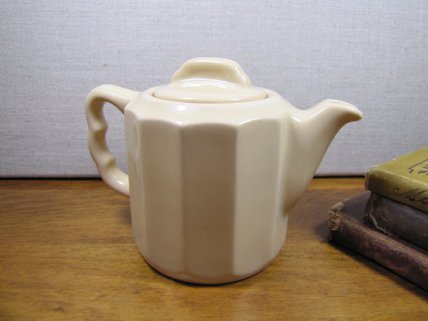Hi! I’ve been so busy I haven’t had time to write! We have been getting ready for an exchange student and it’s amazing how much stuff builds up in your house when you’ve been somewhere for 10+ years. I have a full time job, as well, so the blog took the hit this month. But I wanted to talk about a company that is known as Syracuse China.
I found this pretty little cup and saucer the other day for the shop.

I love the rich colors! This particular pattern is called Lady Louise and comes from about the 1940s. It’s marked Old Ivory, which is the shape, by Syracuse China. I was curious about who they were so if you are, too, let’s find out who they are.

In 1871, according to Syracuse Then and Now, The Onondaga Pottery Company opened it’s doors when sixteen local businessmen banded together and bought a local struggling pottery. This company was also called, O.P.Co. and was located in Geddes, New York, which is now part of Syracuse. The name came from the county in which it was located, as well as a nod to the native Iroquois tribe.

After they capitalized the company for $50,000, they began to expand their white earthenware lines that the old pottery manufactured. O.P.Co. was not located close to the other big potteries in the area. They settled where there were no natural clay sources or coal for running the kilns. No one in the area were clay workers but they were located on the Erie Canal and the railroads so they were able to bring in what they needed easily enough.

The first of O.P.Co.’s Superintendents had hired English potters and trained the local men in making English pottery. In fact, the first company backstamp was a Lion and Unicorn Arms until it was changed in 1873 to the Great Seal of the State of New York. The pottery went undecorated until 1884 when Boston China Decorating Works opened up across the street. They now had access to a designer, printer and hand decorator, at least until a fire destroyed the Boston China Decorating Works in 1886.

So O.P.Co. decided to take everyone into their building thereby establishing one of the earliest in-house decorating departments. At this point, they are still O.P.Co. Syracuse Then and Now says that in 1888 James Pass, the Superintendent at that time who later became president, created America’s “first truly vitreous china body.” (syracusethenandnow.org). Imperial Geddo was a line of fancy accessory pieces that were introduced at the World’s Colombian Exposition in Chicago in 1893 where it won the award for most translucent china.

Two years after the award, the name Syracuse China started showing up on these pieces as a backstamp. Eventually they dropped their other earthenware body pieces and all of their products were vitreous “Syracuse China.”

They became big in the hotel market with a chip-resistant round edge shape introduced in 1896. In 1908 they led the industry in perfecting the under glaze decal process. Then in 1913 Bert Salisbury became president with the death of James Pass. New products that came to market from Salisbury’s time were Old Ivory in 1926 and Adobe in 1931. They also specialized in china for the nation’s railroads.

During WWII, Richard Pass was president and helped the war effort by manufacturing non-detectable ceramic anti-tank land mines. In the 1950s they opened the Onondaga Pottery Electronics Division where they produced “reliable printed circuit components for radio and television manufacturers” (syracusethenandnow.org).

Up until 1971, the company had been been owned by 2 Syracuse families. In 1971 new management took over. They purchased the assets of the company and formed Syracuse China Corporation. In 1978 they merged with Canadian Pacific Investments, Ltd. With this new backing they continued to thrive. There were a few more changes of hands including Susquehanna-Pfaltzgraff and then Libbey owning the company.

Again, we see the merging of all these big industry names as the company morphs over the years. This is how these companies survive in order to weather difficult times and changes in management. It’s interesting how they are interconnected!
Well, that’s it for this week! Please join me at the link parties listed on the right and have a great week!

